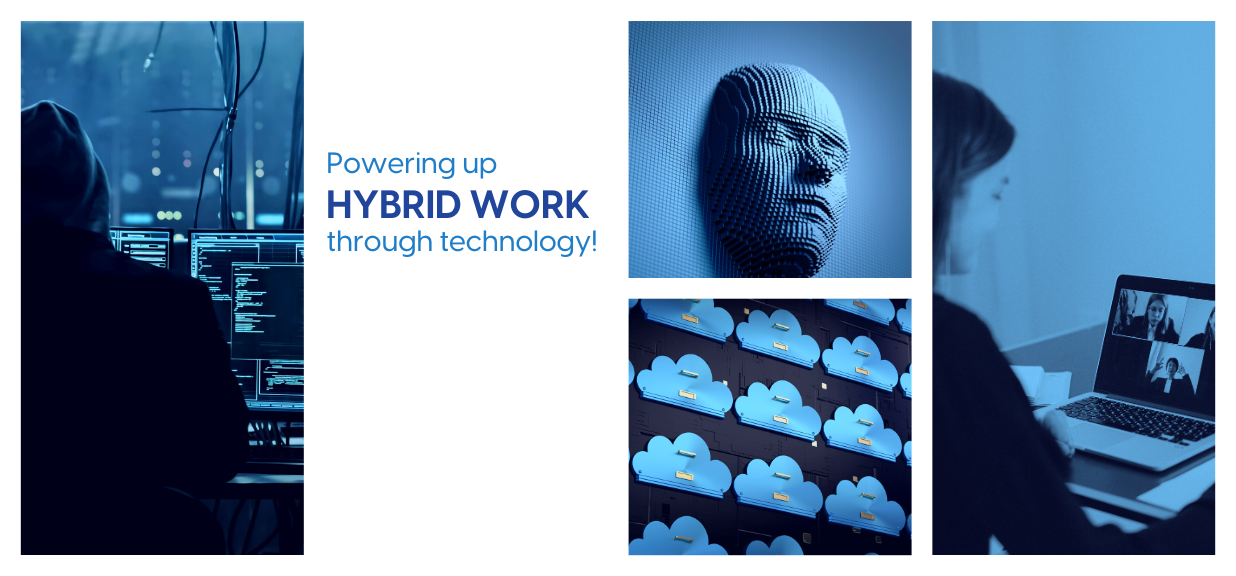Implementing Technology for a successful hybrid work model

In this period of post-pandemic recuperation, do you feel strange after putting on your work clothes? Don't be embarrassed to confess it. We're all in the same boat!
While working from home exclusively has made us fonder of comfy clothes, companies have embraced the flexible work model, which benefits both the organization and its employees.
So, what does Hybrid work from home mean?
Hybrid work is a flexible and innovative way of working that combines both remote and in-office options. It empowers employees to choose where and how they work best while fostering teamwork and communication with their peers.
Examining the Pros and Cons of the Hybrid Work Model
Hybrid work is a growing trend that has both its benefits and challenges.
A survey by McKinsey found that Hybrid work enhanced the productivity of 58% of the employees. However, according to A Survey by Microsoft, communication difficulties were a major challenge of hybrid work for 44% of the respondents.
Despite these difficulties, another Google Workspace and The Economist Group survey indicated that over 75% of respondents believe hybrid work will be standard practice within their organizations in the next three years.
With many challenges, such as ensuring work efficiency, employee involvement, and data protection, technology can play a vital role in facilitating hybrid work and making it effective. Some of which include:
- Cloud-based platforms and tools that enable seamless access to data, applications, and resources from anywhere and any device.
- Video conferencing and collaboration software that facilitates real-time interaction and teamwork among distributed teams.
- Artificial intelligence and automation that enhance efficiency, creativity, and decision-making for hybrid workers.
- Cyber security and privacy solutions that protect hybrid workers and organizations from cyber threats and data breaches.
Also Read | 4 Strategies Critical to implementing a successful Hybrid Work Model
Cloud-based platforms and tools: Before the pandemic, the key use of the cloud was for storage. But since the introduction of the hybrid work model, various cloud apps and tools have come up to ease it. One technology solution that supports this work model is Google Workspace, a platform that enables seamless collaboration and communication among employees. Another solution is cloud computing, which facilitates document management systems. These systems allow secure storage and sharing of files and restricted access to confidential and essential documents for authorized users only.
In the hybrid work environment, cloud-based tools play a significant role in maintaining efficiency and improving collaboration across various sectors. While many industries have adopted general collaboration platforms to manage communication, specific industries benefit from specialized tools. For example, a nail salon scheduling system is crucial in streamlining appointments, reducing waiting times, and enhancing customer satisfaction, much like how businesses leverage digital solutions to improve productivity and operational flow in a hybrid work model. These scheduling systems provide clients with the flexibility to book appointments online while allowing businesses to optimize staff schedules, improving both employee and customer experiences.
Collaboration software: Collaboration software is another technology solution that supports this new work model. It is a system that enables real-time teamwork and communication among employees and groups. Zoom and Microsoft Teams are popular examples of collaboration software that have become essential for collaborating and communicating.
Cyber security and privacy solutions: Data security has always been a serious concern for most organizations. However, the hybrid work model has increased the need for cyber security. Some organizations have adopted VPN (Virtual Private Networks) and VDI (Virtual Desktop Infrastructure) to make data and information safer. These systems allow employees to access the organization's network using their devices, reducing the risk of malware, phishing emails, and other security threats.
AI/Automation: Automation has evolved to support and enhance the hybrid work model. AI is one technology that can benefit current and future workers. For instance, AI can analyze the data collected and suggest what lessons will help prospective employees based on past employees' data or automate repetitive tasks.
Besides these technologies, tools like Neeyamo Absence can help manage employees' leave by easily configuring global leave policies.
Another tool that can facilitate a successful hybrid work model is Neeyamo Time, a time-tracking solution that can track employee movements, streamline time tracking, and improve payroll accuracy.
The Bottom Line
Unequivocally, workers worldwide have clearly expressed their desire for flexibility in their work hours and locations, and companies are responding to that by adopting a mixed work model.
A hybrid work model has allowed organizations to leverage talent from anywhere, build positive work relationships, and enhance the company culture more than ever. With the help of technology, organizations have no excuse to stick to their old model, as switching to a better and more sustainable workplace model is now easy!
If you are ready to embrace the hybrid work model, contact irene.jones@neeyamo.com and let us help you make the transition smooth and successful.
Latest Resources
Stay informed with latest updates
If you're curious and have a thirst for knowledge pertaining to the HR, payroll, and EOR universe, don't miss out on subscribing to our resources.















